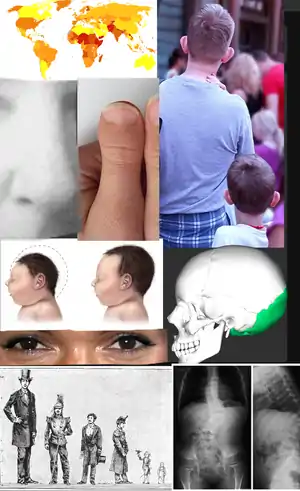Viljoen-Kallis-Voges syndrome
Viljoen Kallis Voges syndrome, also known as microcephaly-brachydactyly-kyphoscoliosis syndrome, is a very rare genetic disorder which is characterized by severe intellectual disabilities, microcephaly, low height, brachydactyly type D, flat occiput, down-slanting palpebral fissures, low-set prominent ears, a broad nose, and kyphoscoliosis.[2][3]
| Viljoen-Kallis-Voges syndrome | |
|---|---|
| Other names | Microcephaly, short stature, brachydactyly type D, flattened occiput, low-set large ears, prominent nose, kyphoscoliosis and intellectual disability, microcephaly brachydactyly kyphoscoliosis[1] |
 | |
| Specialty | Medical genetics |
| Complications | Intellectual disabilities, learning disabilities |
| Usual onset | Birth |
| Duration | Life-long |
| Causes | Genetic mutation |
| Prevention | none |
| Prognosis | Good |
| Frequency | Very rare, only 3 cases have been reported in medical literature. |
This disorder was first discovered in the summer of 1991, by D L Viljoen et al., they described three sisters all over the age of 60 with all of the symptoms described above which were similar to those in Rubenstein-Taybi syndrome.[4] The suspected mode of inheritance is autosomal recessive.[5]
References
- "Viljoen Kallis Voges syndrome".
- RESERVED, INSERM US14-- ALL RIGHTS. "Orphanet: Viljoen Kallis Voges syndrome". www.orpha.net. Retrieved 2022-05-16.
- "Viljoen Kallis Voges syndrome - About the Disease - Genetic and Rare Diseases Information Center". rarediseases.info.nih.gov. Retrieved 2022-05-16.
- Viljoen, Denis L.; Kallis, Jennifer; Voges, Stella; Marais, Anna-Susan; Vuuren, Irene (2008-06-28). "An apparently new mental retardation syndrome in three elderly sisters". Clinical Genetics. 40 (1): 6–11. doi:10.1111/j.1399-0004.1991.tb03062.x. PMID 1884519. S2CID 32397220.
- "Viljoen Kallis Voges Syndrome". DoveMed. Retrieved 2022-05-16.
This article is issued from Wikipedia. The text is licensed under Creative Commons - Attribution - Sharealike. Additional terms may apply for the media files.